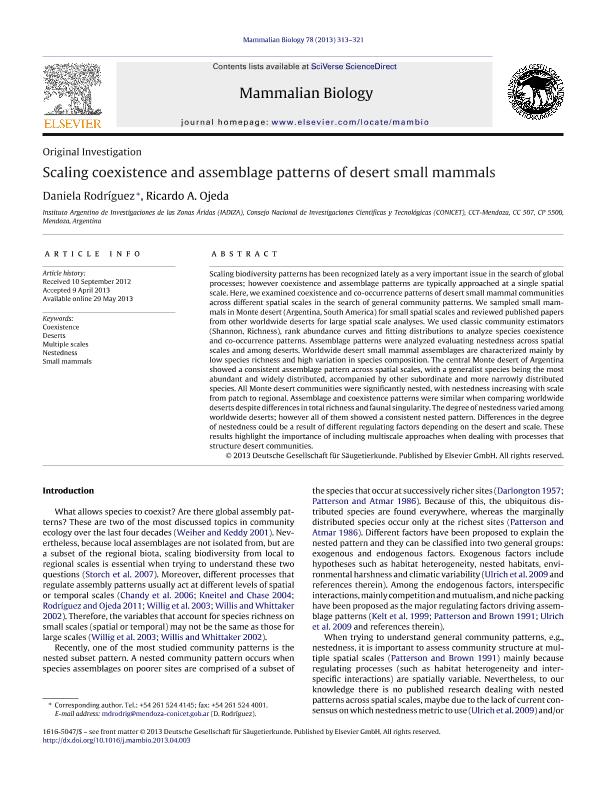Mostrar el registro sencillo del ítem
dc.contributor.author
Rodriguez, Maria Daniela

dc.contributor.author
Ojeda, Ricardo Alberto

dc.date.available
2015-11-13T16:03:23Z
dc.date.issued
2013-09
dc.identifier.citation
Rodriguez, Maria Daniela; Ojeda, Ricardo Alberto; Scaling coexistence and assemblage patterns of desert small mammals; Elsevier Gmbh; Mammalian Biology; 78; 5; 9-2013; 313-321
dc.identifier.issn
1616-5047
dc.identifier.uri
http://hdl.handle.net/11336/2786
dc.description.abstract
Scaling biodiversity patterns has been recognized lately as a very important issue in the search of global processes; however coexistence and assemblage patterns are typically approached at a single spatial scale. Here, we examined coexistence and co-occurrence patterns of desert small mammal communities across different spatial scales in the search of general community patterns. We sampled small mammals in Monte desert (Argentina, South America) for small spatial scales and reviewed published papers from other worldwide deserts for large spatial scale analyses. We used classic community estimators (Shannon, Richness), rank abundance curves and fitting distributions to analyze species coexistence and co-occurrence patterns. Assemblage patterns were analyzed evaluating nestedness across spatial scales and among deserts. Worldwide desert small mammal assemblages are characterized mainly by low species richness and high variation in species composition. The central Monte desert of Argentina showed a consistent assemblage pattern across spatial scales, with a generalist species being the most abundant and widely distributed, accompanied by other subordinate and more narrowly distributed species. All Monte desert communities were significantly nested, with nestedness increasing with scale from patch to regional. Assemblage and coexistence patterns were similar when comparing worldwide deserts despite differences in total richness and faunal singularity. The degree of nestedness varied among worldwide deserts; however all of them showed a consistent nested pattern. Differences in the degree of nestedness could be a result of different regulating factors depending on the desert and scale. These results highlight the importance of including multiscale approaches when dealing with processes that structure desert communities.
dc.format
application/pdf
dc.language.iso
eng
dc.publisher
Elsevier Gmbh

dc.rights
info:eu-repo/semantics/openAccess
dc.rights.uri
https://creativecommons.org/licenses/by-nc-sa/2.5/ar/
dc.subject
Communty Ecology
dc.subject
Small Mammals
dc.subject
Temperate Arilands
dc.subject
Scaling Coexistence
dc.subject
Coexistence
dc.subject
Deserts
dc.subject
Multiple Scales
dc.subject
Netedness
dc.subject.classification
Ecología

dc.subject.classification
Ciencias Biológicas

dc.subject.classification
CIENCIAS NATURALES Y EXACTAS

dc.title
Scaling coexistence and assemblage patterns of desert small mammals
dc.type
info:eu-repo/semantics/article
dc.type
info:ar-repo/semantics/artículo
dc.type
info:eu-repo/semantics/publishedVersion
dc.date.updated
2016-03-30 10:35:44.97925-03
dc.journal.volume
78
dc.journal.number
5
dc.journal.pagination
313-321
dc.journal.pais
Alemania

dc.description.fil
Fil: Rodriguez, Maria Daniela. Consejo Nacional de Investigaciones Científicas y Técnicas. Centro Científico Tecnológico Conicet - Mendoza. Instituto Argentino de Investigaciones de las Zonas Áridas. Provincia de Mendoza. Instituto Argentino de Investigaciones de las Zonas Áridas. Universidad Nacional de Cuyo. Instituto Argentino de Investigaciones de las Zonas Áridas; Argentina
dc.description.fil
Fil: Ojeda, Ricardo Alberto. Consejo Nacional de Investigaciones Científicas y Técnicas. Centro Científico Tecnológico Conicet - Mendoza. Instituto Argentino de Investigaciones de las Zonas Áridas. Provincia de Mendoza. Instituto Argentino de Investigaciones de las Zonas Áridas. Universidad Nacional de Cuyo. Instituto Argentino de Investigaciones de las Zonas Áridas; Argentina
dc.journal.title
Mammalian Biology

dc.relation.alternativeid
info:eu-repo/semantics/altIdentifier/doi/http://dx.doi.org/10.1016/j.mambio.2013.04.003
dc.relation.alternativeid
info:eu-repo/semantics/altIdentifier/url/http://www.sciencedirect.com/science/article/pii/S1616504713000426
Archivos asociados
